Stunning Ethical Dilemmas in Deepfake Filmmaking
Deepfake filmmaking is on the rise, and with it comes a wave of ethical dilemmas that challenge the very fabric of our trust in media, art, and truth itself. At the intersection of technology and creativity, deepfakes—a portmanteau of “deep learning” and “fake”—are reshaping how we tell stories and perceive reality. While these tools open doors to new artistic possibilities, they also raise critical questions about consent, authenticity, and the potential for misuse. In this article, we’ll dive into the stunning ethical dilemmas posed by deepfake filmmaking and explore how they’re reshaping the future of storytelling and media consumption.
—
Deepfakes in Hollywood: Blurring the Lines Between Reality and Fiction

The film industry has always been a pioneer in technological innovation, from CGI to motion capture. Deepfakes are the latest frontier, allowing filmmakers to create stunning visuals, bring historical figures to life, or even resurrect deceased actors. However, with great power comes great responsibility, and the ethical implications are profound.
Take, for instance, the recent trend of using deepfakes to “de-age” actors or even insert lines of dialogue that were never spoken. While these techniques can enhance storytelling, they also raise questions about consent. If an actor’s likeness is altered without their permission, does it count as a violation of their rights? Similarly, the use of deepfakes to create scenes that never happened in historical films can distort our understanding of the past.
One notable example is the viral deepfake video of Tom Cruise that surfaced in 2021. The video, which showed Cruise performing implausible stunts and even doing magic tricks, was so convincing that it left viewers questioning what was real and what wasn’t. While the video was meant as entertainment, it highlighted the potential for deepfakes to manipulate public perception and create false narratives.
—
The Dark Side of Deepfakes: Consent and Identity in Jeopardy
Beyond Hollywood, deepfakes have become a tool for malicious actors, from scammers to stalkers. The technology has been used to create fake videos of individuals engaging in inappropriate behavior, leading to cases of blackmail, harassment, and reputational damage. The psychological toll on victims of deepfake-related abuse is immense, and the legal system is still struggling to keep up with the pace of technological advancement.
One of the most concerning uses of deepfakes is in the realm of revenge porn. Deepfake videos can be used to create false but highly convincing footage of individuals in compromising situations, often without their consent. This has led to a surge in digital harassment cases, with victims facing emotional trauma and even financial losses as their reputations are tarnished.
The ethical dilemma here is twofold. On one hand, the technology itself is neutral—it’s the intent behind its use that determines its impact. On the other hand, the ease with which deepfakes can be created and disseminated online has created a crisis of trust in digital media. As a result, the very foundation of our shared reality is at risk.
—
The Art of Misinformation: Deepfakes and the Erosion of Trust
The rise of deepfakes has also raised concerns about their potential to spread misinformation on a mass scale. Imagine a deepfake video of a political leader making inflammatory remarks, or a fake news anchor delivering false news. The consequences could be catastrophic, from inciting violence to influencing election outcomes.
In 2019, a deepfake video of Mark Zuckerberg surfaced, in which the Facebook CEO appeared to say, “I’m going to assume that I’d rather be the CEO of a company that’s not a democracy, because democracy is a trainwreck.” The video was a sophisticated forgery, and while it was quickly debunked, it served as a stark reminder of the dangers of deepfake technology in the hands of bad actors.
The ethical challenge here is to balance the right to free speech with the need to protect society from the harmful effects of misinformation. Governments and tech companies are grappling with this issue, but consensus is hard to reach. Should deepfake content be banned outright, or should we focus on creating tools to detect and mitigate its impact? The answer lies somewhere in the middle, but the devil is in the details.
—
The Race to Regulate: Can We Keep Up with Deepfake Technology?
As deepfake technology advances, so too must our efforts to regulate its use. However, the rapid pace of innovation has outstripped the ability of lawmakers to keep up. In many countries, there are no specific laws governing the use of deepfakes, leaving a legal vacuum that malicious actors are all too eager to exploit.
In the United States, for example, there is no federal law explicitly addressing deepfakes, though several states have introduced legislation aimed at curbing their misuse. California has passed a law banning the use of deepfakes in political ads, while Virginia has made it illegal to create and distribute deepfake images or videos without consent. These efforts are commendable, but they represent only a fraction of what’s needed.
The ethical dilemma here is not just about regulation but also about education. While laws can help curb the misuse of deepfakes, they won’t address the underlying issue of digital literacy. Too many people are unaware of the potential for deepfakes to manipulate and deceive, leaving them vulnerable to exploitation.
—
The Ethical Future of Deepfake Filmmaking: Navigating the Gray Areas
As we look to the future, it’s clear that deepfakes are here to stay. The question is not whether we should use this technology but how we can use it responsibly. For filmmakers, this means being mindful of the ethical implications of their work and taking steps to ensure that they’re not contributing to the erosion of trust in media.
One potential solution is the development of ethical guidelines for the use of deepfakes in filmmaking. These guidelines could include obtaining consent from individuals whose likenesses are being used, clearly labeling deepfake content so that audiences are aware of what they’re seeing, and avoiding the use of deepfakes in contexts where they could cause harm.
Another important step is to invest in the development of tools to detect and combat deepfakes. While these tools are still in their infancy, they hold the promise of helping us navigate a world where the line between reality and fiction is increasingly blurred.
—
Conclusion: The Power and Peril of Deepfake Filmmaking
Deepfake filmmaking is a double-edged sword, offering incredible creative possibilities while posing significant ethical challenges. As we navigate this brave new world, it’s essential to approach the technology with a critical eye and a commitment to responsible use.
The stunning ethical dilemmas posed by deepfakes are a reminder that innovation must always be tempered with wisdom. Whether we’re talking about Hollywood blockbusters, political propaganda, or malicious scams, the impact of deepfakes on our culture and society cannot be overstated.
As a reader of BeNewsMag.com, we invite you to explore more of our cutting-edge coverage on technology, innovation, and the intersection of art and ethics. Join the conversation in the comments below and share your thoughts on how we can navigate the challenges of deepfake filmmaking while preserving the integrity of our shared reality.
—
Reflection: Writing about the ethical dilemmas in deepfake filmmaking has been a fascinating journey. The technology is undeniably impressive, but it’s equally unsettling. As I delved deeper into the topic, I realized just how delicate the balance between innovation and ethics is. Let’s hope that as deepfakes continue to evolve, we can find ways to harness their power without losing sight of what’s right.

